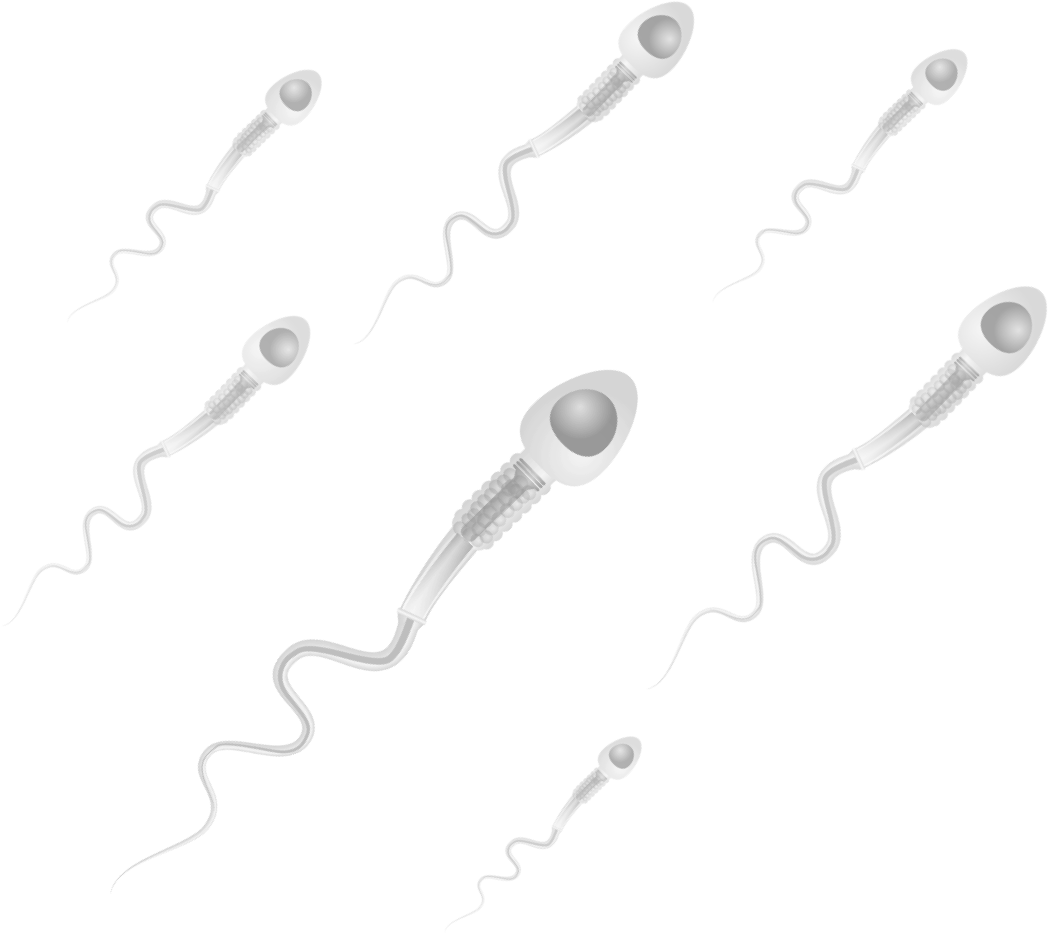Semen Analysis

What is a Semen Analysis?
A semen analysis is a test run on semen to analyze the health and viability of a man’s sperm. Sperm is the male reproductive cell, or gamete, that contains the male’s genetic information. Semen is the fluid containing sperm plus other substances like sugars and proteins released during ejaculation.
A semen analysis measures three major factors (along with a few others) to determine sperm viability:
- the number of sperm, or sperm count
- the shape of the sperm, or morphology
- the movement of the sperm, or motility
Why is a Semen Analysis Important?
As you likely know, the goal of the male reproductive system is to deposit happy and healthy sperm inside the vagina where it can then swim up the female reproductive tract to fertilize an egg traveling down the fallopian tube. Unfortunately, this process doesn’t always work, and while many people incorrectly assume that any problems conceiving are directly related to the female partner, it is merely not true.
Dr. Edward Ditkoff, a reproductive endocrinologist, typically tells couples that “30% of infertility is related to male factor alone; 30% of infertility is related to female factor alone; 10% of the time we don’t know what’s causing the infertility; 30% of the time there’s a combination of male and female factors. So, up to 50% of fertility can be related to a malefactor.”
That means when a couple can’t get pregnant, it’s essential to assess both the male and female partners (if applicable).
A semen analysis, otherwise known as a sperm count, is the first and cornerstone test to assess a male’s fertility adequately. It’s an important diagnostic tool that can help indicate male factor infertility. Regardless of whether a man has previously fathered a child or is otherwise healthy, a semen analysis is the only way to identify or rule out a problem with the male partner’s sperm.
How to Prepare for a Semen Analysis
To perform a semen analysis, the male partner must masturbate and collect a clean semen sample in a sterile cup either at home or at a fertility center. For the most accurate results, men are advised to:
- Avoid ejaculating for 24-72 hours prior.
- Not use any lotions or gels during the collection process
- Avoid alcohol, caffeine, and any drugs for 2-5 days prior
- It’s also sure to discuss any medications you’re currently taking with your provider. He or she may instruct you to stop taking them before your test.
Getting A Good Sample
Besides the preparations mentioned above, the best sample is obtained by masturbation directly into a sterile cup without the use of lubrication and without touching the penis to the container.
Samples can usually be collected at home or at the fertility clinic/testing facility.
If the sample is collected at home, it is critical that:
- the semen is kept as near to body temperature until it is tested. If it gets too warm or too cold, the results can be inaccurate.
- The semen is delivered to the testing facility within 90 minutes of leaving the body (preferably much sooner).
- For both of these reasons, it is generally recommended men produce samples in a private room at the testing site. If a home sample is collected, one should travel with the specimen container between their legs (if possible) or close to their body to maintain the proper temperature.
Semen Analysis Test
As mentioned a semen analysis looks to confirm the presence of sperm in the semen and check three main attributes of the sperm:
- Sperm Count (number of sperm)
- Morphology (shape and appearance)
- Motility (movement)
That said, a complete semen analysis will also measure:
- Volume
- pH (level of acidity)
- Progression (motion and forward progress)
- Semen viscosity (consistency)
- The presence or absence of white, red blood cells, or immature sperm
To analyze the sample in the lab, a small volume of the specimen is then placed on a Makler counting chamber, which has a grid with 100 squares. The sperm concentration is determined by counting the number of sperm in ten squares, then multiplying by 1 million. The motility of the specimen is determined by calculating the percentage of the sperm that are moving in the same ten squares. The progression of the sperm (forward motion) is graded on a scale of 0 (no motility) to 3+ (moving quickly across the grid in a forward direction). The pH, agglutination (attraction between sperm), viscosity (gelatinous texture of the sample), and the number of red and white blood cells are recorded. A morphology slide of the semen is also prepared. This allows the sperm to be stained and viewed under a high-power microscope to determine the percentage of sperm with normal morphology (shape).
Semen Analysis Results: What Do They Mean?
What the results of your semen analysis mean are as important as what they don’t mean. Regardless of your numbers—good or bad—they don’t seal your reproductive fate. In fact, a Stanford University study of the initial semen analysis from 1,089 couples were studied to determine whether their results predicted their future fertility. Researchers concluded that there were no statistically significant differences between the cumulative probability of conception for couples with sperm analysis results at the high end and lower end and that using specific values of the semen analysis to estimate the potential for fertility of infertile couples was not useful.
Semen analysis results simply act as a guide for helping to determine the most effective fertility treatment. Low motility or poor morphology might make a case for ICSI as opposed to conventional IVF fertilization or IUI.
Normal Semen Analysis
Semen analysis results are available pretty quickly, usually within 24 hours, but sometimes they take up to several days, depending on your lab. Listed below are the parameters determined by the World Health Organization for a normal semen analysis:
| Concentration: | >20 million sperm per milliliter |
| Volume: | 2-5 mL |
| Motility: | >50% |
| pH: | 7.2-7.8 |
| White Blood Cells: | <5 per high-powered field |
| Progression: | 2+-3+ |
| Red Blood Cells: | 0 per high-powered field |
| Agglutination: | None |
| Morphology: | > 14% normal forms |
If a sample is determined to be below these standards, the couple may be experiencing male factor infertility. However, a normal semen analysis does not necessarily eliminate male factor infertility. This is because a semen analysis is testing for the phenotypic (how it looks) attributes of the semen, not the genotypic (the genetic composition) attributes of the sperm.
Abnormal Semen Analysis
If your semen analysis comes back as abnormal, it is often recommended to look at the man’s:
- Follicle-Stimulating Hormone (FSH): a sex hormone that in males helps maintain adequate sperm production
- Luteinizing hormone (LH): a sex hormone that stimulates the production of Testosterone
- Prolactin: Used to help determine problems related to the pituitary gland and testosterone levels
- Testosterone: Low Testosterone levels can alter the production of sperm due to its central role in sperm production.
- Thyroid Stimulating Hormone (TSH): Low thyroid levels can cause poor semen quality, testicular function, and disturb sex drive.
It may be also be advised that you retest. You may need to schedule a consult with a urologist who specializes in male infertility for further diagnostic testing. An abnormal semen analysis can be the result of a variety of causes, including lifestyle factors, infection, or other medical conditions, a blockage to the passage of sperm, or genetic conditions affecting sperm production.
Depending on the severity of the male factor, couples may still be able to undergo IUI (Intrauterine Insemination) treatments, or they may be referred on to IVF (In Vitro Fertilization) with ICSI (Intra Cytoplasmic Sperm Injection), where one sperm is directly injected into an egg, bypassing the need for millions of sperm.
The good news is that specific lifestyle changes can help improve sperm quality. CNY Fertility recommends a male fertility enhancement “protocol” that uses changes in diet, supplementary support, and pharmacological advances to improve sperm count, motility, overall function, and live birth results for those trying to conceive, both with and without fertility treatments.
Semen Analysis Cost
A semen analysis can often cost multiple hundreds of dollars if not covered by insurance. However, as with everything at the nation’s most affordable, CNY Fertility charges significantly less than the national average for those without insurance coverage who are stuck with the full bill out of pocket. In fact, our semen analysis costs only $50.


